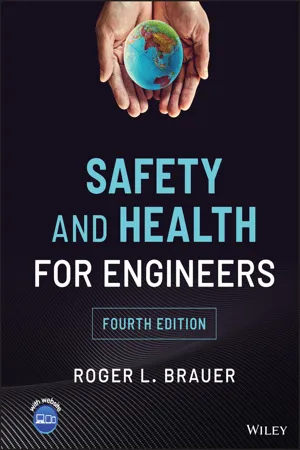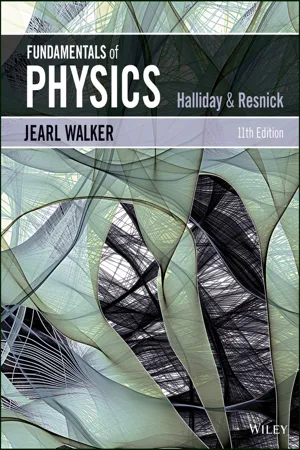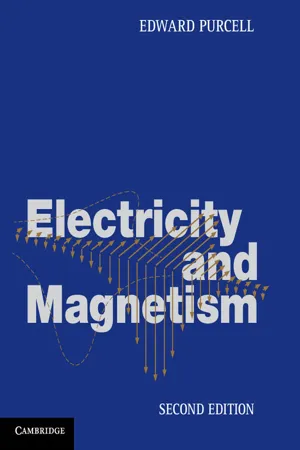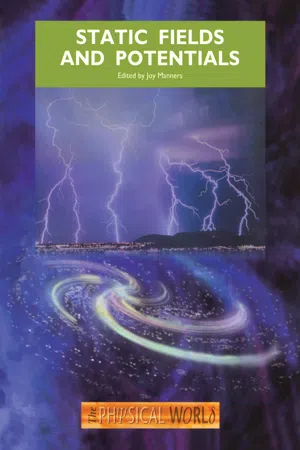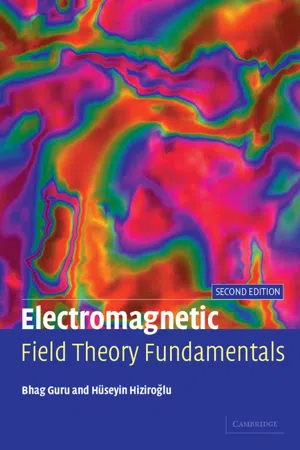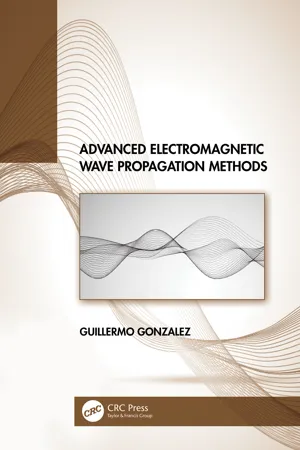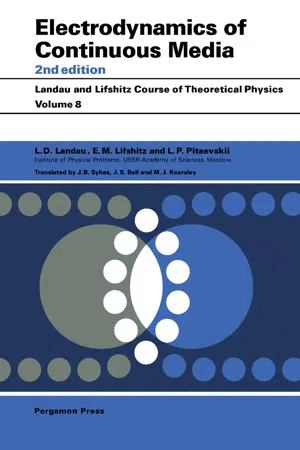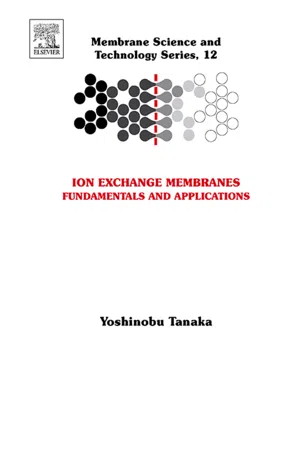Physics
Current Density
Current density refers to the amount of electric current flowing through a given cross-sectional area of a conductor. It is a vector quantity, with both magnitude and direction, and is typically denoted by the symbol J. Current density is an important concept in physics, particularly in the study of electromagnetism and the behavior of conductive materials.
Written by Perlego with AI-assistance
Related key terms
1 of 5
11 Key excerpts on "Current Density"
- eBook - ePub
- Roger L. Brauer(Author)
- 2022(Publication Date)
- Wiley(Publisher)
Resistance is a function of the material over which electrons move. If electrical energy or charge is to move from one point to another, there must be a difference in energy level between the two points. There must also be some conductive material that connects the two points.Electrons will flow primarily through the path of least resistance. At times, there is more than one path between two points with each path differing in electrical resistance level.Current Density
Current Density is the amount of current flowing through a conductor per unit of cross‐sectional area. If the area is large, the Current Density is low. If it is small, Current Density is high. Current and Current Density are important for dealing with electrical safety.Resistance
All materials exhibit some resistance to the flow of electricity. Materials that allow electrons to flow easily are conductors. Some good conductors are copper, other metals, water, and electrolytic fluids. Insulators are materials that do not allow electrons to flow easily. Examples of insulators are rubber, glass, wood, air and other gases, and most plastics.The total resistance to the flow of electrons is the sum of all resistances presented by the flow path. One or more materials can create the flow path. For a single material of length l and a given cross‐sectional area, the resistance R is given by:where(12.2 )ρ = resistivity in ohms per unit length σ = conductivity in unit length per ohm Reference tables list resistivity and conductivity of various materials. Equation (12.2 ) shows that resistivity and conductivity are reciprocals, with conductivity the more commonly used property. Table 12-1 gives resistivity for selected copper wire sizes.Heating
A material creating a resistance to electron flow introduces heating, another phenomenon important for electrical safety. The temperature of a conductor will rise as the current flow increases. The energy lost to resistance changes to heat energy, a process called Joule heating. The amount of heat produced can be determined from Joules law: - eBook - PDF
- David Halliday, Robert Resnick, Jearl Walker(Authors)
- 2018(Publication Date)
- Wiley(Publisher)
748 CHAPTER 26 CURRENT AND RESISTANCE 26-2 Current Density Learning Objectives After reading this module, you should be able to . . . 26.05 Identify a Current Density and a Current Density vector. 26.06 For current through an area element on a cross section through a conductor (such as a wire), identify the element’s area vector dA → . 26.07 Find the current through a cross section of a con- ductor by integrating the dot product of the Current Density vector J → and the element area vector dA → over the full cross section. 26.08 For the case where current is uniformly spread over a cross section in a conductor, apply the relationship between the current i, the Current Density magnitude J, and the area A. 26.09 Identify streamlines. 26.10 Explain the motion of conduction electrons in terms of their drift speed. 26.11 Distinguish the drift speeds of conduction electrons from their random-motion speeds, including relative magnitudes. 26.12 Identify charge carrier density n. 26.13 Apply the relationship between Current Density J, charge carrier density n, and charge carrier drift speed v d . ● Current i (a scalar quantity) is related to Current Density J → (a vector quantity) by i = ∫ J → · dA → , where dA → is a vector perpendicular to a surface ele- ment of area dA and the integral is taken over any sur- face cutting across the conductor. The Current Density J → has the same direction as the velocity of the moving charges if they are positive and the opposite direction if they are negative. ● When an electric field E → is established in a conduc- tor, the charge carriers (assumed positive) acquire a drift speed v d in the direction of E → . ● The drift velocity v → d is related to the Current Density by J → = (ne) v → d , where ne is the carrier charge density. - eBook - PDF
- Edward Purcell(Author)
- 2011(Publication Date)
- Cambridge University Press(Publisher)
4.1 4.2 4.3 4.4 4.5 4.6 4.7 4.8 4.9 4.10 4.11 Electric Current and Current Density Steady Currents and Charge Conservation Electrical Conductivity and Ohm 's Law The Physics of Electrical Conduction Conduction in Metals Semiconductors Circuits and Circuit Elements Energy Dissipation in Current Flow Electromotive Force and the Voltaic Cell Networks with Voltage Sources Variable Currents in Capacitors and Resistors Problems ELECTRIC CURRENTS 124 126 128 133 142 144 148 153 154 157 159 161 124 FIGURE 4.1 (a) A swarm of charged particles all moving with the same velocity u. The frame has area a. The particles which will pass through the frame in the next ;:;'1 sec are those now contained in the oblique prism (b). The prism has base area a and altitude u t:.t cos e, hence its volume is au t:.t cos 0 or a . u t:.t. (a) (b) --- 1'\'"--- 1\ I \ I \ I I I I I I I \ \ I 0 \ \I CHAPTER FOUR ELECTRIC CURRENT AND Current Density 4.1 An electric current is charge in motion. The carriers of the charge can be physical particles like electrons or protons, which may or may not be attached to larger objects, atoms or molecules. Here we are not concerned with the nature of the charge carriers but only with the net transport of electric charge their motion causes. The electric current in a wire is the amount of charge passing a fixed mark on the wire in unit time. In CGS units current will be expressed in esu/sec. The SI unit is coulombs/sec, or amperes (amps). A current of 1 ampere is the same as a current of 2.998 X 10 9 esu/sec, which is equivalent to 6.24 X 10 18 elementary electronic charges per second. It is the net charge transport that counts, with due regard to sign. Negative charge moving east is equivalent to positive charge moving west. - eBook - ePub
- Roger E. Harrington(Author)
- 2012(Publication Date)
- Dover Publications(Publisher)
CHAPTER 2CHARGE DENSITY AND Current Density
2-1. Charge Density. In circuit theory, we speak of a charge on a conductor or in a region. If we have a charged conductor and divide it into two parts, we find that there is a portion of the original charge on each part. This leads us to the concept that charge is distributed over the conductor with a certain charge density. From atomic theory, however, we know that electric charge is composed of aggregations of charged particles (electrons, protons, etc.). We might therefore question the validity of introducing a continuous charge density. But the charges with which we are concerned are composed of such a large number of atomic particles that this “atomicity” of charge is unimportant. Our procedure is analogous to the use of mass density in mechanics, even though mass is composed of atomic particles.We define the volume charge density q v at a point in a region of continuous charge distribution as the limit of the charge per volume contained within an element of volume surrounding the point as the element volume goes to zero.1 In mathematical form, this is(2-1)where q denotes the charge contained in the infinitesimal volume element τ . The volume charge density is a scalar point function and is measured in coulombs per cubic meter. The total charge contained in a region of continuous charge distribution is the volume integral of this charge density. Thus(2-2)gives the charge within the region over which the volume integral is taken.Sometimes the charge appears to be contained within a thin surface layer. We define the surface charge density q s as the limit of charge per area on an element of surface as the element area goes to zero. In mathematical form, this is(2-3)where q denotes the charge contained on the infinitesimal surface element s . As implied by the defining equation, surface charge density is measured in coulombs per square meter. The total charge on a surface having a surface density of charge is the surface integral of q s - eBook - PDF
- David Halliday, Robert Resnick, Jearl Walker(Authors)
- 2021(Publication Date)
- Wiley(Publisher)
The total current through the surface is then i = J → ⋅ dA → . (26.2.1) If the current is uniform across the surface and parallel to dA → , then J → is also uni- form and parallel to dA → . Then Eq. 26.2.1 becomes i = J dA = J dA = JA, so J = i __ A , (26.2.2) where A is the total area of the surface. From Eq. 26.2.1 or 26.2.2 we see that the SI unit for Current Density is the ampere per square meter (A/m 2 ). In Chapter 22 we saw that we can represent an electric field with electric field lines. Figure 26.2.1 shows how Current Density can be represented with a similar set of lines, which we can call streamlines. The current, which is toward the right in Fig. 26.2.1, makes a transition from the wider conductor at the left to the narrower conductor at the right. Because charge is conserved during the transition, the amount of charge and thus the amount of current cannot change. However, the Current Density does change—it is greater in the narrower conductor. The spacing of the streamlines suggests this increase in Current Density; streamlines that are closer together imply greater Current Density. Drift Speed When a conductor does not have a current through it, its conduction electrons move randomly, with no net motion in any direction. When the conductor does have a current through it, these electrons actually still move randomly, but now they tend to drift with a drift speed v d in the direction opposite that of the applied electric field that causes the current. The drift speed is tiny compared with the speeds in the random motion. For example, in the copper conductors of household wiring, electron drift speeds are perhaps 10 –5 or 10 –4 m/s, whereas the random-motion speeds are around 10 6 m/s. We can use Fig. 26.2.2 to relate the drift speed v d of the conduction electrons in a current through a wire to the magnitude J of the Current Density in the wire. 794 CHAPTER 26 CURRENT AND RESISTANCE For convenience, Fig. - eBook - PDF
- David Halliday, Robert Resnick, Jearl Walker(Authors)
- 2020(Publication Date)
- Wiley(Publisher)
Then Eq. 26-4 becomes i = ∫ J dA = J ∫ dA = JA, so J = i A , (26-5) where A is the total area of the surface. From Eq. 26-4 or 26-5 we see that the SI unit for Current Density is the ampere per square meter (A/m 2 ). In Chapter 22 we saw that we can represent an electric field with electric field lines. Figure 26-4 shows how Current Density can be represented with a similar set of lines, which we can call streamlines. The current, which is toward the right in Fig. 26-4, makes a transition from the wider conductor at the left to the narrower conductor at the right. Because charge is conserved during the transition, the amount of charge and thus the amount of current cannot change. However, the Current Density does change — it is greater in the narrower conductor. The spacing of the streamlines suggests this increase in Current Density; streamlines that are closer together imply greater Current Density. Drift Speed When a conductor does not have a current through it, its conduction electrons move randomly, with no net motion in any direction. When the conductor does have a current through it, these electrons actually still move randomly, but now they tend to drift with a drift speed v d in the direction opposite that of the applied electric field that causes the current. The drift speed is tiny compared with the speeds in the random motion. For example, in the copper conductors of household wiring, electron drift speeds are perhaps 10 –5 or 10 –4 m/s, whereas the random-motion speeds are around 10 6 m/s. We can use Fig. 26-5 to relate the drift speed v d of the conduction electrons in a current through a wire to the magnitude J of the Current Density in the wire. For 650 CHAPTER 26 CURRENT AND RESISTANCE convenience, Fig. 26-5 shows the equivalent drift of positive charge carriers in the direction of the applied electric field E → . - eBook - ePub
- Joy Manners(Author)
- 2020(Publication Date)
- CRC Press(Publisher)
Chapter 3 Electric currents DOI: 10.4324/9780429187797-41 An electric world
The matter that makes up our Universe is intrinsically electrical in its nature: the electrons and protons within all atoms possess the property of electric charge. Atoms themselves are electrically neutral, but it is not uncommon for atoms either to lose or to gain electrons. Motion, either of a detached electron, or of a charged atom (which is known as an ion), constitutes a flow of electric charge, which is known as an electric current.Such motion occurs in a very wide variety of situations (Figure 3.1 ). For example:- in and above the atmosphere of the Earth, the motion of charged particles produces such phenomena as lightning and the aurora;
- within our bodies, the flow of ions across the walls of cells allows us to activate our muscles, and even to think;
- in a bewildering variety of technological devices, electric currents are the agent through which we interact with the world. Consider electric lights and motors, televisions or radios, CD players and computers.
Thus, one can fairly say that the flow of electrically charged particles represents an important topic for study.Figure 3.1 Electric currents in the everyday world: the current during a lightning flash is very large: the motion of charged particles in the upper atmosphere is responsible for the aurora; complex circuitry inside a computer; pylons carry cables that distribute electricity from power stations to our homes and factories.For most of this chapter we will look at a phenomenological description of electric currents. In the following chapter we will build on the description developed here in order to understand the relationship between electric currents and the generation of magnetic fields.2 What is an electric current?
An electric current is a ‘flow of electric charge’. However, electric charge does not exist by itself: it is a property of the fundamental particles that constitute matter. Thus, the nature of an electric current differs from one circumstance to another depending on which charged particles are contributing to the flow, and the situation of these charged particles. For example, in metals, an electric current consists of a flow of negatively charged electrons through a background of positive ions, but in a solution (such as the liquid in a car battery) an electric current consists of a flow of both - eBook - PDF
- Bhag Singh Guru, Hüseyin R. Hiziroglu(Authors)
- 2009(Publication Date)
- Cambridge University Press(Publisher)
The convection current is due to the flow of charges in a vacuum. The conduction current results from the flow of electrons in a conductor. The current per unit area was defined as the Current Density. The convection Current Density is J = ρ v U v where ρ v is the volume charge density and U v is the average velocity of these charges. The conduction Current Density is J = σ E where σ is the conductivity of the medium and E is the electric field intensity within the conductor. The resistance of a conductor, in terms of the field quantities, is R = a b − E · d s J · d s For a linear medium, R = σ A where is the length, σ is the conductivity, and A is the area of the conductor. We obtained a general expression for the equation of continuity as ∇ · J = − ∂ρ v ∂ t which reduced to ∇ · J = 0 for steady current through a medium. The potential distribution in a linear, isotropic, and homogeneous conducting medium satisfies Laplace’s equation. That is, ∇ 2 V = 0 167 4.11 Summary The solution of this equation enables us to determine the E field, the D field, the Current Density J , the current I , and the resistance of the medium. If we place an excess charge within a conductor, it will redistribute over the surface of the conductor according to the following equation: ρ v = ρ 0 e − t /τ where τ = /σ is the relaxation time. For all practical purposes, the charge will vanish from the interior of the conductor in a time t = 5 τ . The power dissipated by a conductor as heat is P d = I 2 R = V 2 R and the power associated with a conducting medium, in terms of field quantities, is P = v E · J d v From the boundary conditions between two conducting media, we found that the normal components of J are continuous at the interface. - Guillermo Gonzalez(Author)
- 2021(Publication Date)
- CRC Press(Publisher)
E. The proportionality is expressed in the formP =(1.2.13)ε oχ eEwhereχ eis the electric susceptibility. Substituting (1.2.13) into (1.2.11) givesD =(1.2.14)ε o( 1 +Eχ e)The term(is known as the relative permittivity1 +)χ eε r(also known as the dielectric constant). The permittivity of the dielectric ε is given byand (1.2.14) is written asε =(1.2.15)ε oε r=ε o( 1 +χ e)From (1.2.16) the displacement current is defined asD = ε E =(1.2.16)ε oε rE(1.2.17)J d== ε∂ D∂ t∂ E∂ tIt is interesting to note that in electrostatics∇ × E = 0, but from (1.2.11)∇ × D = ∇ × P ≠ 0. Hence, while the electrostatic field E can be expressed as the gradient of a potential, in a dielectric the same cannot be said for D.Matter contains atoms and atoms contain electrons. The spin and orbital motion of electrons around the nucleus give rise to a loop current that can be described by a time-varying magnetic dipole. The current loops are associated with the motion of these electrons in atoms. If there are N atoms per unit volume there is a net magnetization M, which represents the total magnetic dipole moment( N m )per unit volume, and this gives rise to a magnetic Current Density. A magnetic dipole m is represented by time-varying magnetic charges±separated by a distanceq m( t )Δ L. In undergraduate courses it is shown that the magnetization is related to a magnetic Current Density by(1.2.18)J M= ∇ × MwhereJ Mis a bound current. The magnetization current is different from any impressed current. Observe that (1.2.18) shows that∇ •J M= 0- eBook - ePub
- L D Landau, J. S. Bell, M. J. Kearsley, L. P. Pitaevskii, E.M. Lifshitz, J. B. Sykes(Authors)
- 2013(Publication Date)
- Pergamon(Publisher)
CHAPTER IIISTEADY CURRENT
Publisher Summary
In a steady current, the spatial distribution of electric Current Density is independent of time. The electric field in the conductor in which a steady current flows is constant. An electric field in the presence of a current does mechanical work on the current-carrying particles moving in the conductor. This work is dissipated into heat in the conductor. The evolution of heat results in an increase in the entropy of the body. The work required for a thermodynamically reversible removal of the particle is called the work function. This quantity is always positive. The work function depends both on the nature of the conductor and on that of the charged particle. The work function is the characteristic of the surface of the conductor. It, therefore, depends, for instance, on the treatment of the surface and the contamination of it. If the conductor is a single crystal, then the work function is different for different faces.§21 The Current Density and the conductivity
Let us now consider the steady motion of charges in conductors, i.e. steady electric currents. We shall denote by j the mean charge flux density or electric Current Density. † In a steady current, the spatial distribution of j is independent of time, and satisfies the equationdiv j = 0 ,(21.1)(21.1)which states that the mean total charge in any volume of the conductor remains constant. The electric field in the conductor in which a steady current flows is constant, and therefore satisfies the equationcurl E = 0 ,(21.2)(21.2)i.e. it is a potential field.Equations (21.1) and (21.2) must be supplemented by an equation relating j and E. This equation depends on the properties of the conductor, but in the great majority of cases it may be supposed linear (Ohm’s law - eBook - PDF
Ion Exchange Membranes
Fundamentals and Applications
- Yoshinobu Tanaka(Author)
- 2007(Publication Date)
- Elsevier Science(Publisher)
The measuring process of the Current Density distribution is as follows based on Fig. 9.5 : (1) Electric potential at a point x , y is measured using a calomel electrode and equipotential lines are drawn from equipotential points. (2) The electrode surface is divided by n in the y -direction. Line 1 perpen-dicular to the equipotential line a is drawn at the point x , y . A circle in 0.0 0.2 0.4 0.6 0.8 6.0 1.2 0 1 2 3 4 5 6 7 i (A/dm 2 ) x (m) : 0.106 : 0.12 : 0.2 : 0.6 eq/dm 3 C ' in Figure 9.3 Effect of electrolyte concentration at the inlets of desalting cells on Current Density distribution. Ion Exchange Membranes: Fundamentals and Applications 194 contact with the equipotential line b being nearest to a is drawn on the basis of the point x , y . Line 2 perpendicular to the equipotential b is drawn at the contact point between the circle and the line b . The electric force line is obtained by linking the line 1 with the line 2. Insulator Cathode Electrodial y zer Anode (x,y) Figure 9.4 Instrument for measuring Current Density distribution around an insulator. Figure 9.5 Computing diagram of Current Density distribution. Current Density Distribution 195 (3) D l and D m are measured at every point x , y . D l is the value in the range of D m between A 1 and A 2 . (4) Current Density at the point x , y , i x , y , is calculated using the following equation: i x ; y ¼ ¯ i ð 1 = D l Þ x ; y ð 1 = n Þ P n y ¼ 1 ð 1 = D l Þ x ; y (9.42) where ¯ i is the average Current Density on the surface of the electrode. Saito (1966) measured the electric current distribution setting ¯ i ¼ 1 A dm 2 and changing the dimension of an insulator as shown in Fig. 9.6 . 9.2.2 Equivalent Network Circuit The Current Density distribution is possible to be analyzed as follows by using the equivalent network circuit ( Tanaka, 1984 ). We assume insulators to be arranged in an electrolyte solution as shown in the system of Fig.
Index pages curate the most relevant extracts from our library of academic textbooks. They’ve been created using an in-house natural language model (NLM), each adding context and meaning to key research topics.
